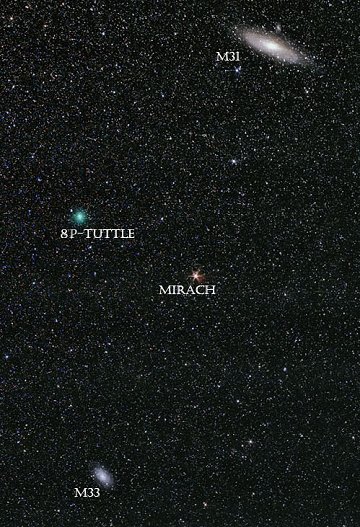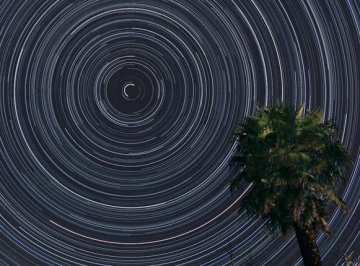 Where's Saturn? Is that a UFO--or the ISS? What's the name of that star? Get the answers from mySKY--a fun new astronomy helper from Meade. Where's Saturn? Is that a UFO--or the ISS? What's the name of that star? Get the answers from mySKY--a fun new astronomy helper from Meade. ASTRO PHOTO-OP: Got a GOTO telescope? On Sunday night, command it to slew to spiral galaxy M33. You'll see not only the galaxy in your eyepiece, but also green Comet 8P/Tuttle. The comet and the galaxy are having a photogenic close encounter--less than half-a-degree apart on Dec. 30 and 31. Günther Strauch of Borken, Germany, has prepared a composite image showing what the view may look like. "It will be a special night for astrophotography," he says. NEW YEARS COMET: After a 13.6 year absence, Comet 8P/Tuttle is once again traveling through the inner solar system and on Jan. 1st and 2nd it makes its closest approach to Earth--only 24 million miles away. The emerald-colored comet will brighten to a predicted magnitude of 5.8, visible to the unaided eye from dark-sky sites and a fine target for backyard telescopes: sky map. Last night in the mountains of northern Italy, Giampaolo Salvato took a picture of Comet 8P/Tuttle, see below, using no telescope at all. "This is a 5 minute exposure with my Canon 5D digital camera set at ISO 400," he says. 
Click on the image for an even wider view, which encompasses exploding Comet 17P/Holmes, variable star Algol, the Andromeda Galaxy (M31) and some lovely star clusters. Comet Tuttle is racing across this starry expanse for a Dec. 30th encounter with spiral galaxy M33--a can't-miss event for astrophotographers. Stay tuned for photos! Comet 8P/Tuttle Photo Gallery
[World Map of Comet Sightings]
[sky map] [comet binoculars] [ephemeris] [orbit] WARNING: Staring at this photo may make you dizzy: 
These are star trails--slow, graceful arcs traced by the stars as Earth spins on its axis. "A full 180° rotation of the circumpolar stars can be obtained only at this time of year when the astronomical night lasts more than 12 hours," says photographer Lorenzo Comolli. "I took this all-night picture on Dec. 28-29 using my Canon 350D on a tripod in light polluted Tradate, Italy." The stubby arc near the center of the swirl is Polaris, also known as "the North Star" because Earth's north pole points almost directly at it. Polaris may be the most famous star in the heavens--but fame is fleeting! Earth's spin axis is precessing and in 10,000 years or so white-hot Vega (six times brighter than Polaris) will take over as North Star. Star trail photos will look even prettier then, with an intense bright dot illuminating the core of the starry whirlpool. more images: from Don Martel in the Namib Desert of Namibia, Africa; from Larry Landolfi of Rochester, New Hampshire; from Gary Shaw of Flagstaff Arizona. | 
